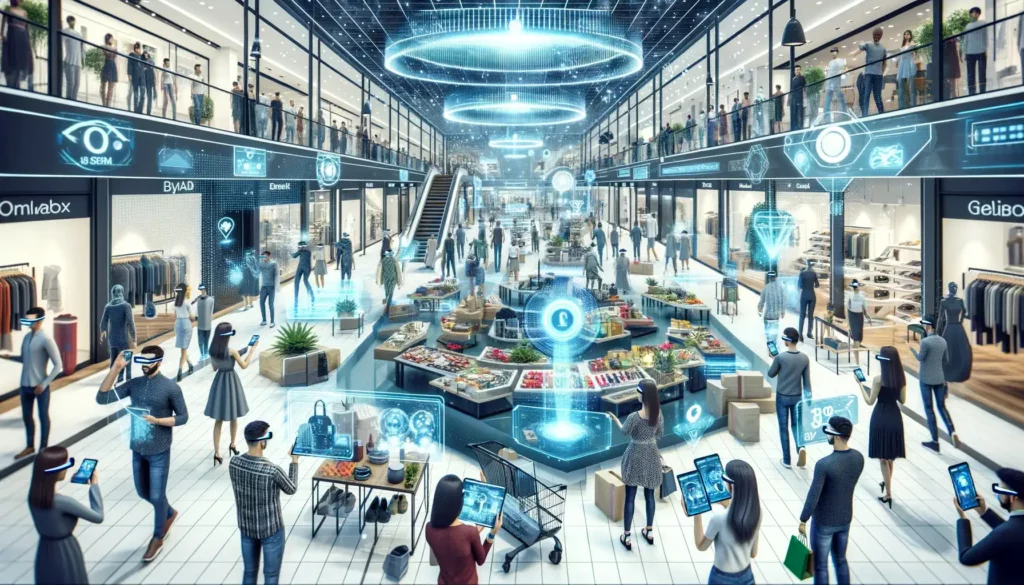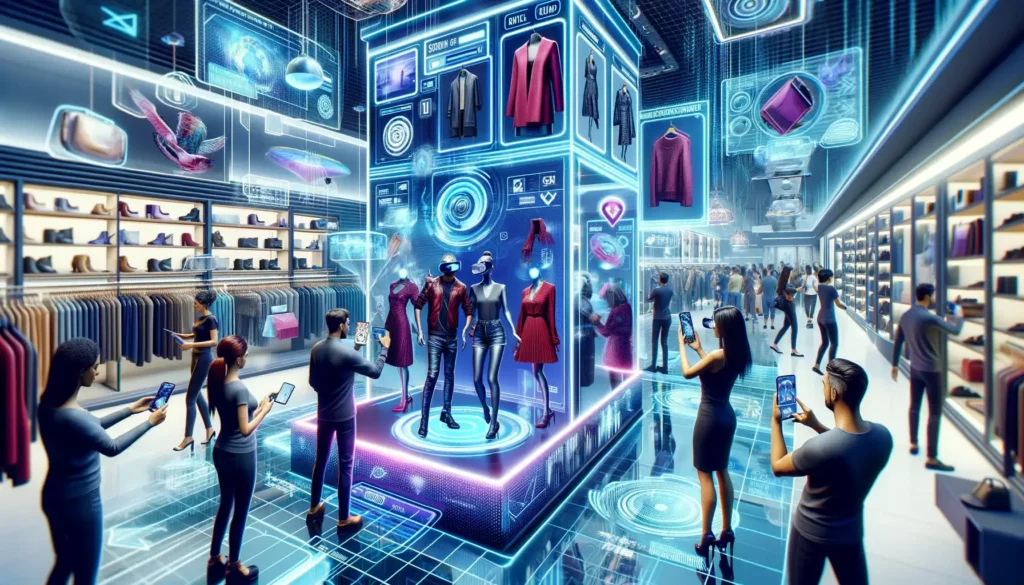Businesses are constantly looking for innovative ways to enhance the online shopping experience for their customers. Augmented reality (AR) technology has emerged as a game changer.
This advanced technology seamlessly combines the virtual and physical worlds, opening up new opportunities for interactive and immersive shopping. This article examines the impact of AR in e-commerce, reviews its applications, benefits, and promising future.
Section 1: The Rise of AR in E-commerce
The rise of AR in e-commerce is a transformative force that has changed the way people shop online.
Augmented reality (AR), which was initially developed for military and industrial use, has now opened its way to the consumer space such as: gaming industry, healthcare, etc., which has caused a great impact of AR in e-commerce.
Simply put, AR enhances our understanding of the real world by superimposing digital information onto our physical environment. This is achieved through the use of devices such as smartphones or augmented reality glasses, creating an immersive experience that blurs the lines between the digital and physical realms.
Recent statistics show a significant increase in the integration of AR solutions by online retailers. Consumers, now more than ever, are looking for interactive and engaging shopping experiences, and AR technology meets this demand by providing a unique and visually rich environment.

Section 2: Applications of AR in E-commerce
The virtual experiences provided by AR represent a fundamental shift in the way we shop. It allows users to virtually try on clothes and accessories from their home.
No more guessing what that trendy dress or pair of shoes will look like – AR provides an immersive and realistic preview, improving the overall shopping experience.
As we move forward, AR in e-commerce will provide consumers with greater confidence, engagement and enjoyment.
Here we explore the success stories of brands that have seamlessly integrated AR trial experiences.
1.Zara:
Zara, a pioneer in the fashion industry, has implemented virtual try-ons through augmented reality, allowing users to imagine how different clothes will look before purchasing.
This approach has not only reduced the uncertainty associated with online shopping, but also significantly increased user confidence.
2. Sephora:
The well-known cosmetics brand, Sephora, offers customers the opportunity to test various cosmetic products virtually by offering AR solutions.
This technology gives customers confidence in how a lipstick or nail polish will appear on their skin or nails. This engaging and experiential interaction reinforces customers’ personal preferences when shopping for cosmetics online.
3. Nike AR sports shoes test:
Nike, the global leader in sportswear, has introduced an augmented reality-based trial experience for sneakers.
Customers can use their smartphones to virtually try on different styles and colors, providing an interactive and personalized shopping journey.

Section 3: Augmented Reality Benefits and Solutions for Businesses and Consumers
(How AR captures and retains customer attention)
Attracting and retaining customer attention has always been a paramount challenge in the digital marketplace. AR solutions have emerged as a powerful tool in addressing this challenge, transcending the boundaries of traditional online shopping.
These AR solutions allow customers to interact with products in real time, significantly enhancing the sense of connection and personalization. This not only enriches the customer experience but also dramatically improves the efficacy of online shopping platforms. Businesses utilizing these cutting-edge AR solutions distinguish themselves in the crowded digital market, offering unique and immersive shopping experiences that captivate and retain customers.
Real-life examples of businesses increasing engagement through AR technology:
-IKEA interactive catalogs:
IKEA, a global furniture retailer, has introduced interactive catalogs, AR technology. Customers can use their smartphones to scan catalog pages and bring furniture items to life in 3D.
This interactive approach not only informs customers about product details, but also makes the shopping experience more enjoyable and attractive.
-warby Parker virtual tests:
warby Parker, a popular eyewear brand, uses AR technology to virtually try on eyewear. It allows customers to see how different frames look on their face through the smartphone camera, improving the decision-making process and increasing engagement.
This personal and interactive feature increases customer satisfaction.
-Snapchat AR Shopping Lenses:
Social media giant Snapchat has integrated AR shopping lenses that allow users to virtually try on and purchase products directly from the app.
This innovative approach not only enables user interaction, but also integrates social interaction with e-commerce.

Section 4: The future of AR technology
The future of AR in e-commerce promises countless innovations that will change the way we perceive and interact with online shopping. Here are some emerging trends that are set to improve the AR shopping experience:
4.1 Emerging innovations in AR for e-commerce:
-Integration of augmented reality XR:
The combination of augmented reality (AR), virtual reality (VR) and mixed reality (MR) leads to extended reality (XR). This integration provides users with more immersive and integrated experiences and allows them to explore products in virtual spaces.
-Advanced personalization through artificial intelligence:
Artificial intelligence (AI) plays a fundamental role in enhancing personalization in AR experiences. AI algorithms analyze user behavior, preferences and past interactions to tailor augmented reality content to user behavior and make the shopping journey more relevant and engaging.
-Web-based AR experiences:
In the future, we will see the widespread adoption of web-based AR experiences, which will eliminate the need for users to download separate applications. This accessibility democratizes augmented reality, making it more user-friendly and easily accessible to a wider audience.
4.2 Predictions about continued evolution and widespread adoption:
–AR as a standard in e-commerce:
In the future, augmented reality will become an essential feature in the e-commerce landscape. As technology advances and consumer expectations grow, businesses that embrace augmented reality will gain a competitive advantage by providing more immersive, interactive and personalized shopping experiences.
–AR Integration Beyond Retail:
The influence of AR will extend beyond traditional retail. Industries such as real estate, automotive, and healthcare are increasingly using AR to visualize, simulate, and interact with customers more. The integration of AR will bridge the gap between the digital and physical worlds in various sectors.
Conclusion
Augmented reality continues to evolve e-commerce, and businesses that embrace this technology will gain a competitive advantage.
From virtual trials to interactive shopping experiences, AR has proven to be a powerful tool in increasing customer engagement and satisfaction. The future of e-commerce looks bright and inclusive thanks to the limitless possibilities that augmented reality brings to the realm of digital shopping.
Expect amazing changes in the dynamic world of AR technology.















